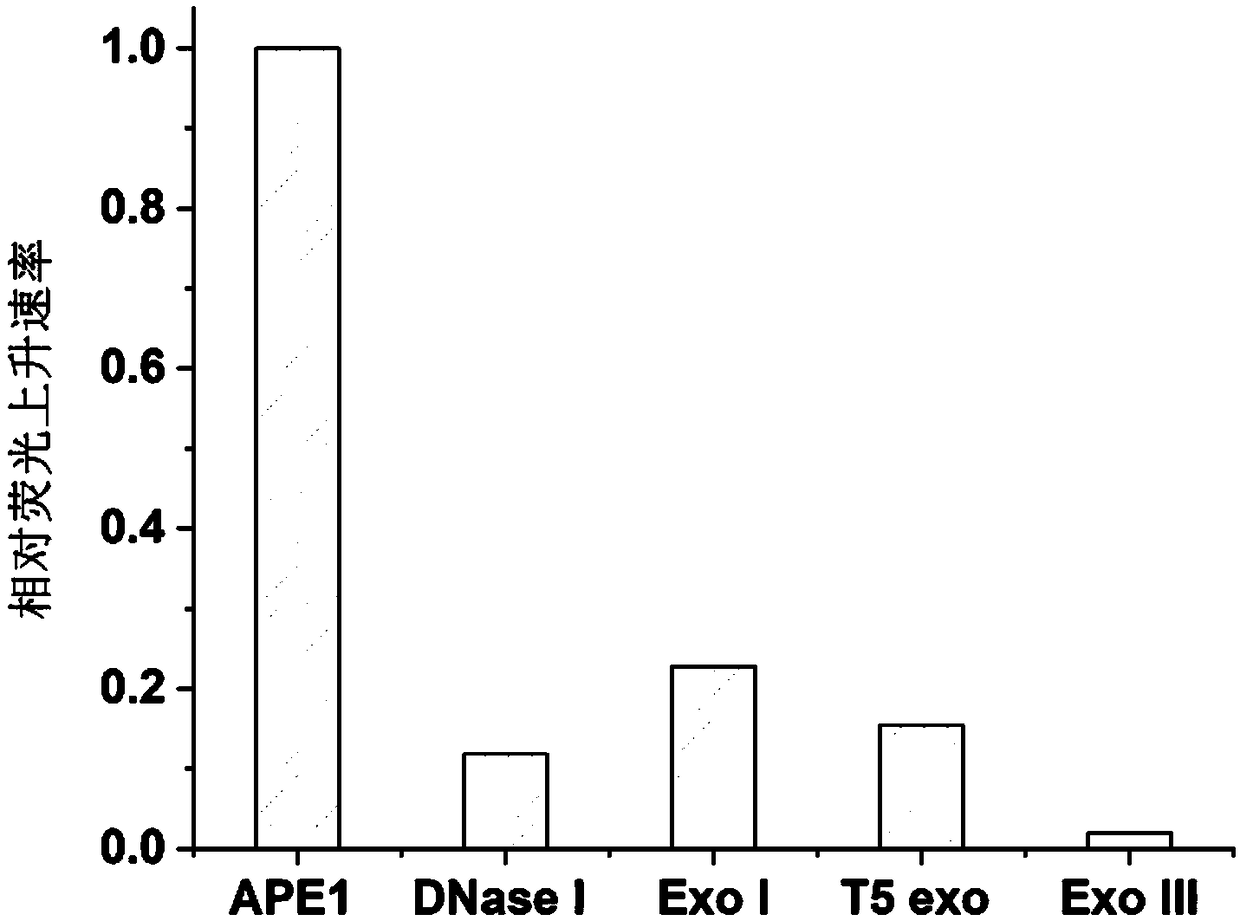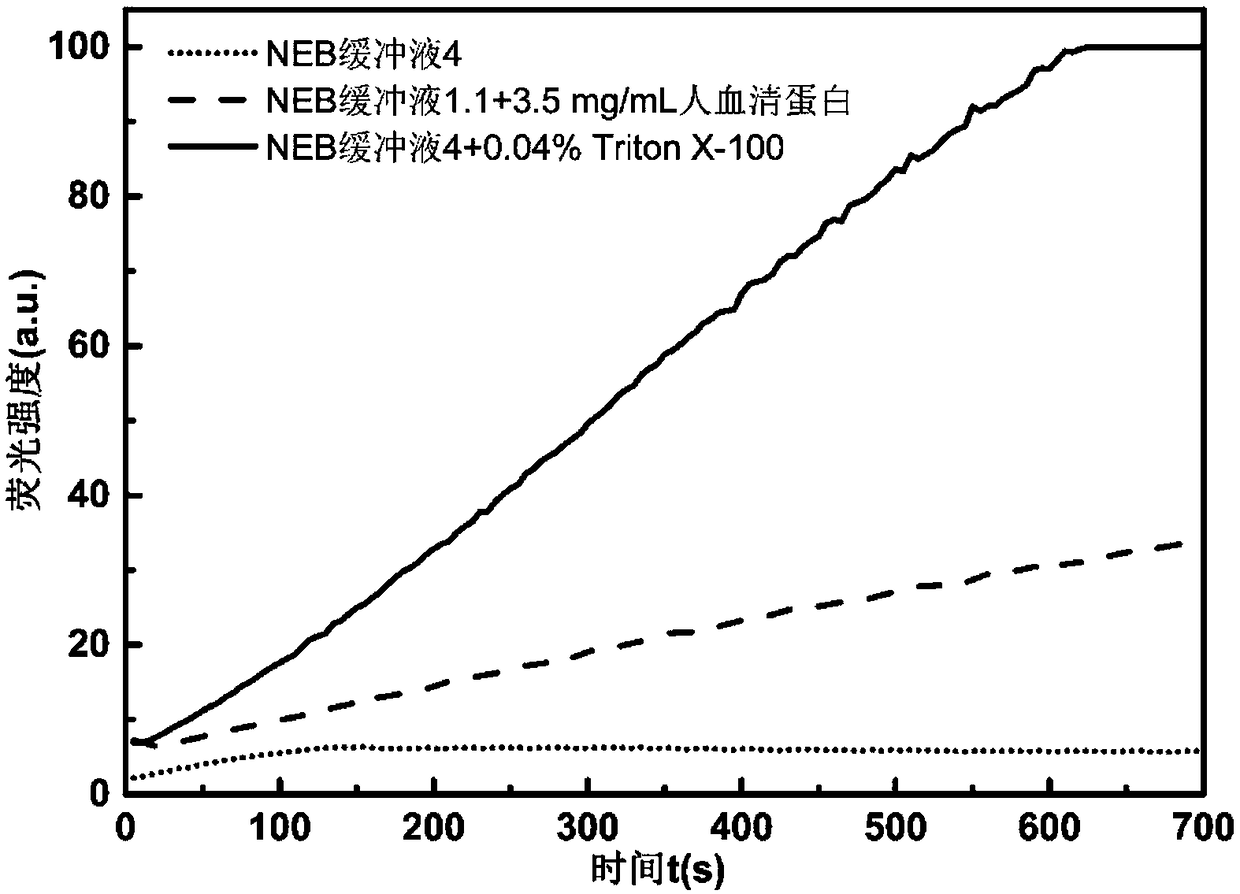Fluorescent probe and kit for abasic endonuclease 1 as well as application
A base nucleic acid and fluorescence detection technology, applied in the determination/inspection of microorganisms, DNA/RNA fragments, recombinant DNA technology, etc., can solve the problems of high recovery rate, interference probe response, insufficient sensitivity, etc. High sensitivity and good stability
- Summary
- Abstract
- Description
- Claims
- Application Information
AI Technical Summary
Problems solved by technology
Method used
Image
Examples
Embodiment 1
[0051] Example 1
[0052] In the research results reported by APE1, the most suitable substrate for this enzyme is a DNA duplex containing an abasic site. With hydrolysis ability. This was also confirmed in our experiments. The DNA / RNA hybrid strand probes formed by hybridizing the D-1 strand and the RNA-probe strand in Table 1-1 did not respond to the increase of APE1 fluorescence. However, in our other experiments, we accidentally found that when the 5' direction of the abasic site in the DNA chain is a G base, the bacterial-derived similar enzyme EndoIV of APE1 can directly hydrolyze the DNA single strand, and when the abasic site When the 3' direction of the site has a weak binding effect on the complementary strand, it is beneficial for APE1 to attack the abasic site. Based on these reaction characteristics, we conceived an APE1 probe, which is a DNA / RNA hybrid probe, in which there is an abasic site on the DNA chain, and the 5' side of the abasic site is a G base , ...
Embodiment 2
[0065] Example 2
[0066]In this example, the reaction buffer of APE1 was optimized first. In the method reported before using DNA duplexes containing abasic sites as probes, the APE1 reaction buffer used was NEB buffer 1.1 (10mM Bis-Trispropane-HCl, 10mM MgCl 2 , 100 μg / mL bovine serum albumin) and then add 3.5 mg / mL human serum albumin. In this example, NEB buffer 4 (50mM KAc, 20mM Tris-Ac, 10mM Mg(Ac) 2 , 1mM DTT), on this basis, 0.04% (v / v) Triton X-100 was added to obtain a new reaction buffer.
[0067] The specific steps for detecting different concentrations of APE1 are as follows:
[0068] In the above-mentioned APE1 reaction buffer solution, 200nM APE1 probe and different concentrations of APE1 solutions were added respectively, and the solution was immediately detected in real-time fluorescence at 37° C. in a real-time fluorescent PCR instrument. According to the change curve of fluorescence intensity with time, the fluorescence rising rate is obtained, which is...
Embodiment 3
[0072] Example 3
[0073] We added different concentrations of biotin antibody to the reaction solution, and found that it could speed up the reaction rate between APE1 and the probe, further improving the detection sensitivity. The specific experimental steps are as follows:
[0074] In the reaction buffer solution optimized in Example 2, add the APE1 probe and biotin antibody solutions of different concentrations, mix well, add the APE1 standard solution, and immediately perform real-time fluorescence detection on the solution in a real-time fluorescent PCR instrument at 37°C . According to the change curve of fluorescence intensity with time, the fluorescence rising rate is obtained, which is the hydrolysis efficiency of APE1 to APE1 probe at the concentration of the biotin antibody solution.
[0075] The above reactions were all carried out in a 50 μL reaction system, the APE1 probe concentration was 200 nM, the biotin antibody solution concentrations were 0, 1, 2, 4, a...
PUM
 Login to View More
Login to View More Abstract
Description
Claims
Application Information
 Login to View More
Login to View More - R&D
- Intellectual Property
- Life Sciences
- Materials
- Tech Scout
- Unparalleled Data Quality
- Higher Quality Content
- 60% Fewer Hallucinations
Browse by: Latest US Patents, China's latest patents, Technical Efficacy Thesaurus, Application Domain, Technology Topic, Popular Technical Reports.
© 2025 PatSnap. All rights reserved.Legal|Privacy policy|Modern Slavery Act Transparency Statement|Sitemap|About US| Contact US: help@patsnap.com



